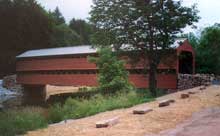Bridge Construction
Bridges are often categorized by the type of construction technique used to build them. Early bridges were often simple utilitarian forges accross small streams, but larger, greater capacity bridges were soon needed. Stone arch bridges with stone wing walls and a single or multiple stone arches to the support the bridge deck were built accross the state, but in great abundance in the southeast corner. The stone would be either mortared or dry laid, usually using native rock such as limestone.
Covered bridges likewise were built everywhere in our state and beyond, employing common bridge construction techniques such as stone support piers, wooden decking and a variety of support patterns for the roof and wall parts of the bridge. Some covered bridges have lattice type walls and roof supports. Covered bridges came in all sizes and sometimes appeared as "twins" with two small bridges adjacent to one another providing a crossing over two bodies of water. The early "Camelback Bridge" in Harrisburg across the Susquehanna River was a mile long covered bridge with a river island in the middle and a humped appearance due to the undulating roofline.
Truss bridges, forged of iron with varying patterns of joined supports are another significant type of bridge construction. Some Pennsylvania companies like the Phoenix Bridge Company in Phoenixville were famous for their innovative and decorative truss bridge designs. There are various types of truss bridges - Pratt trusses, Burr trusses, Warren trusses, Baltimore trusses, King trusses, Parker trusses, most named for their creators or early proponents.
Poured concrete bridges came into common use around the turn of the 20th century and some of these are also considered historic due to their design or construction innovations.
Photos
Click the thumbnails for larger images.

